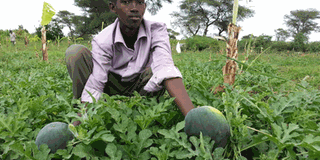Keep the food aid, we now grow our own

Isse Hussein Ali displays some of the watermelon fruits growing on his farm in Balich, Garissa County. PHOTO | BONIFACE MWANGI | NATION MEDIA GROUP
What you need to know:
- “We have now started using traditional pest control methods to fight diseases. We use ash and spray our crops with pepper and tobacco. This helps to kill and keep pests at bay.”
- Watering of crops is done through flood irrigation. The farmers have dug canals, which distribute water to their farms.
- “Each family cultivates between one and two acres. This is to allow us to plant crops we want.” Exploitation by middlemen, pests and lack of agricultural extension officers are among the challenges they face.
At one time, the vast semi-arid land in Balich village, Garissa County was covered with acacia trees and thorny plants, which thrive in such environments.
Some of the plants were mainly eaten by camels and cows that the pastoralists in the region keep. But that was then, today, the land has been transformed into a large lush garden where different crops are flourishing.
Bananas, tomatoes, capsicum and watermelons are some of the crops the over 50 families of Balich are now growing, besides keeping animals.
“We are happy that we are now farming, just like other people in different parts of Kenya. We no longer depend on animals or food aid for our sustenance,” says Mohammed Rashid, 57, a former herder. For many years, Rashid and fellow villagers believed that the only farming they could engage in was keeping animals.
“We never thought we could grow crops here. During wet seasons, only shrubs would grow. Then when the dry season came, the land would turn from green to brown as crops withered.”
Through their own initiative, they started growing capsicum and tomatoes.
“It was over seven years ago. Three of us cleared five acres and planted tomatoes. At first they did not do well, but we did not give up. We kept on planting as we diversified crops. They later did well, attracting pastoralists from neighbouring villages,” he recalls.
The farmers used to source water from River Tana to irrigate their crops.
Diesel generator to pump
As the number of people showing interest in farming grew, Rashid and 11 others contributed Sh1,000 each to expand their activities.
“Each of us was to contribute Sh1,000 or a goat for those who could not raise cash. The goats were sold and the money used to clear more land for farming. Some money was also set aside to buy a diesel generator to pump water from River Tana to our farms.”
Watering of crops is done through flood irrigation. The farmers have dug canals, which distribute water to their farms.
“We cleared more than 50 acres of the community land near River Tana, where we are currently growing the crops. We subdivided the land into different parts for each family. We are now about 50 families engaging in farming,” says Rashid.
Isaac Muhammed, 50, says apart from the dwindling fortunes in pastoralism, he got tired of waiting for relief food from the government and well-wishers every time the rains disappeared.
“There are days we stayed without eating because we did not have food. We had to move to other areas in search of food for our animals and ourselves, but since we embraced farming, we have solved the problem.”
In a month, Muhammed earns more than Sh20,000 from selling watermelons and bananas.
“Each family cultivates between one and two acres. This is to allow us to plant crops we want.” Exploitation by middlemen, pests and lack of agricultural extension officers are among the challenges they face.
“We have now started using traditional pest control methods to fight diseases. We use ash and spray our crops with pepper and tobacco. This helps to kill and keep pests at bay.”
Isse Ali notes middlemen flock their farms to buy the produce at low prices, which they ferry to Garissa town.
“They come here, buy watermelon at Sh20 and go and sell at Sh50. It is because we do not have better marketing channels. We hope the county government will assist us because we have talked to the agriculture officials,” says the 17-year-old.
The farmers also have to content with wild animals that include giraffes, antelopes and monkeys, which invade their farms regularly.
“We have not diversified our crops because residents do not eat foods like kale and cabbages or maize,” says Ali.
The young farmer adds he earns more than Sh50,000 per harvest from his watermelons. He also grows mangoes, which earn him over Sh35,000 while his one acre of banana plantation gives him Sh70,000 per harvest.
During the dry season, farmers with livestock don’t have to travel long distances in search of pastures. They harvest banana stalks and weeds from their gardens, which they feed their animals.
“With my family guaranteed of food, I can now attend to other things and diversify my income. Our farming scheme is a great blessing,” says Muhammed, whose children don’t miss school to look for pasture and food.




